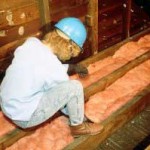 By insulating your home effectively you secure it with a thermal barrier that can resist heat and cold. However, you will always need some yardstick to gauge how strong the barrier is. This is where the R-value comes into picture. To define, R-value is the efficiency rating for any given insulation technique.
By insulating your home effectively you secure it with a thermal barrier that can resist heat and cold. However, you will always need some yardstick to gauge how strong the barrier is. This is where the R-value comes into picture. To define, R-value is the efficiency rating for any given insulation technique.
Real and nominal R-value are two different things
There is a number printed on your insulation package but you will do well to remember that at best this number may represent a nominal value. When you ask the mileage of a car, the showroom dealer tells you a figure which is equivalent to its highway mileage- the ideal mileage. City roads tell a different story though.
Similarly, nominal R-value is far from the real one because method of installation, vulnerability of a home towards leakages, and outside temperature comes into play.
Fibreglass insulation
To understand the point better, think about fibreglass insulation. If you have gone for the batt type you know what you are getting into. No questions about its effectiveness but cracks and crevices around the batt zone will render it a low R-value for sure.
Same can happen in case of a tear. Having said this, if perfectly installed, fibreglass batt insulation can give your walls a very high R-value without forcing an unsightly thickness on them.
Polyicynene insulation
As an insulation material, Polyicynene foam behaves almost similar to the batt foam and offers similar R-value range too. It has the ability to expand nearly 100 times its dimensions and can be a handful if applied evenly. However, if external stimuli force its uneven application you can be rest assured about a big crash in its R-value.
Cellulose insulation
In cases when the insulation material is made of paper, wetness can drastically minimise the R-value. Cellulose insulation is a case in the point.
In short, and to reiterate once again, R-value denotes thermal resistance but the difference between its nominal and real value can be great and will depend at large on the condition of your home.
Which type of insulation do you use at your home?

